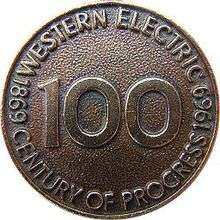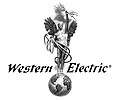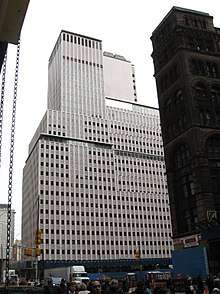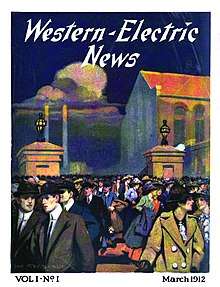Western Electric
The Western Electric Company was an American electrical engineering and manufacturing company that was officially founded in 1869 and, as a wholly owned subsidiary of AT&T for most of its lifespan, served as the primary equipment manufacturer, supplier, and purchasing agent for the Bell System from 1881 to 1984 when it was dismantled. The company was responsible for many technological innovations, including the development of the transistor, as well as seminal developments in industrial management.
| Industry | Telecommunications |
|---|---|
| Fate | Absorption, remnants operating as Nokia |
| Successor |
|
| Founded | 1869 |
| Defunct | February 7, 1996 |
| Headquarters | Manhattan, New York City, US. |
| Products | Telephones, Central office switches, computers, electrical and electronics parts, and all other telecommunications related products supplied to Bell System companies |
| Parent | AT&T (1881–1996) |
History
In 1856, George Shawk, a craftsman and telegraph maker, purchased an electrical engineering business in Cleveland, Ohio.[1] On December 31, 1869, he entered a partnership with Enos M. Barton, and later sold his share to inventor Elisha Gray. In 1872, Barton and Gray moved the business to Clinton Street, Chicago, Illinois, and incorporated it as the Western Electric Manufacturing Company. They manufactured a variety of electrical products including typewriters, alarms, and lighting and had a close relationship with telegraph company Western Union, to whom they supplied relays and other equipment.
In 1875, Gray sold his interests to Western Union, including the caveat that he had filed against Alexander Graham Bell's patent application for the telephone. The ensuing legal battle between Western Union and the Bell Telephone Company over patent rights ended in 1879 with Western Union withdrawing from the telephone market and Bell acquiring Western Electric in 1881.

Western Electric was the first company to join in a Japanese joint venture with foreign capital. In 1899, it invested in a 54% share of the Nippon Electric Company, Ltd. Western Electric's representative in Japan was Walter Tenney Carleton.
In 1901, Western Electric secretly purchased a controlling interest in a principal competitor, the Kellogg Switchboard & Supply Company, but in 1909 was forced by a lawsuit to sell back to Milo Kellogg.
On July 24, 1915, employees of the Hawthorne Works boarded the SS Eastland in downtown Chicago for a company picnic. The ship rolled over at the dock and over 800 people died. (See The Eastland disaster.)
In 1920, Alice Heacock Seidel was the first of Western Electric's female employees to be given permission to stay on after she had married. This set a precedent in the company, which previously had not allowed married women in their employ. Miss Heacock had worked for Western Electric for sixteen years before her marriage, and was at the time the highest-paid secretary in the company. In her memoirs, she wrote that the decision to allow her to stay on "required a meeting of the top executives to decide whether I might remain with the Company, for it established a precedent and a new policy for the Company - that of married women in their employ. If the women at the top were permitted to remain after marriage then all women would expect the same privilege. How far and how fast the policy was expanded is shown by the fact that a few years later women were given maternity leaves with no loss of time on their service records."
In 1925, ITT purchased the Bell Telephone Manufacturing Company of Brussels, Belgium, and other worldwide subsidiaries from AT&T, to avoid an antitrust action. The company manufactured rotary system switching equipment under the Western Electric brand.
Early on, Western Electric also managed an electrical equipment distribution business, furnishing its customers with non-telephone products made by other manufacturers. This electrical distribution business was spun off from Western Electric in 1925 and organized into a separate company, Graybar Electric Company, in honor of the company's founders, Elisha Gray and Enos Barton.
Bell Telephone Laboratories was half-owned by Western Electric, the other half belonging to AT&T.
Company logos
Western Electric used various logos during its existence. Starting in 1914 it used an image of AT&T's statue Spirit of Communication.
 1914 company masthead logo (Spirit of Communication)
1914 company masthead logo (Spirit of Communication) Logo until circa 1969
Logo until circa 1969 Logo 1969–1984
Logo 1969–1984
Development of a monopoly
In 1915, the assets of Western Electric Manufacturing were transferred to a newly incorporated company in New York, New York, named Western Electric Company, Inc,[3] a wholly owned subsidiary of AT&T. The sole reason for the transfer was to provide for the issuance of a non-voting preferred class of capital stock, disallowed under the statutes of the state of Illinois.[4]
All telephones in areas where AT&T subsidiaries provided local service, all components of the public switched telephone network (PSTN), and all devices connected to the network were made by Western Electric and no other devices were allowed to be connected to AT&T's network. AT&T and Bell System companies were rumored to employ inspectors to check electrical conditions of household subscriber lines to identify use of non-leased telephones by consumers.
Western Electric telephones were owned not by end customers but by the local Bell System telephone companies—all of which were subsidiaries of AT&T, which also owned Western Electric. Each phone was leased from the phone company on a monthly basis by customers who generally paid for their phone as part of the recurring lease fees. This system had the effect of subsidizing basic telephone service, keeping local phone service inexpensive, under $10 per month, including the leased phone. After divestiture, basic service prices increased, and customers were now responsible for inside building wiring and telephone equipment. The Bell System had an extensive policy and infrastructure to recycle or refurbish phones taken out of service, replacing all defective, weak, or otherwise unusable parts for new installations. This resulted in extraordinary longevity of Western Electric telephones, and limited the variety of new designs introduced into the market place.
AT&T also strictly enforced policies against using telephone equipment by other manufacturers on their network. A customer who insisted on using a telephone not supplied by the Bell System had to first transfer the phone to the local Bell operating company, who leased the phone back to the customer for a monthly charge in addition to a re-wiring fee. In the 1970s when consumers increasingly bought telephone sets from other manufacturers, AT&T changed the policy for its Design Line telephone series by selling customers the phone housing, retaining ownership of the internal mechanical and electrical components, which still required paying AT&T a monthly leasing fee.

Until 1983, Western Electric telephones or their components could only be leased by subscribers and never resold, and were repaired by the Bell System operating companies at no charge to the customer. This led Western Electric to pursue extreme reliability and durability in design to minimize service calls. In particular, the work of Walter A. Shewhart, who developed new techniques for statistical quality control in the 1920s, helped lead to the legendary quality of manufacture of Western Electric telephones. Starting in 1983, Western Electric telephones could be sold to the public under the brand name American Bell, a newly created subsidiary of AT&T. One of the terms of the Modification of Final Judgment in the Bell System divestiture procedures prohibited AT&T from using the name Bell after January 1, 1984; prior to this, AT&T's plan was to market products and services under the American Bell name, accompanied by the now familiar AT&T globe logo.
One of AT&T's competitors in providing telephone service in the U.S., General Telephone and Electronics (GTE), also operated an equipment manufacturing unit, Automatic Electric near Lisle, Illinois.
Manufacturing plants
In 1905, Western Electric began construction of the Hawthorne Works on the outskirts of Chicago and which, by 1914 had absorbed all manufacturing work from Clinton Street and Western Electric's other plant in New York City. Later large factories included the Kearny Works in Kearny, New Jersey, Columbus Works in Columbus, Ohio, and Kansas City Works in Lee's Summit, Missouri.[5] By the time AT&T was dissolved in the early 1980s, more than twenty production plants around the country ("Works" locations) had been established.[6][7] Locations of these facilities included:
- Columbia River Switching Equipment Works, Vancouver, Washington (crossbar switching equipment - 590 IBEW employees in 1974)[8][9]
- Hawthorne Works, Cicero, Illinois (metal parts/tools, capacitors, thin-film circuits, switchboards)
- Montgomery Works, Montgomery, Illinois (telephone parts)[10]
- Kearny Works, Kearny, New Jersey (power supplies and other equipment)
- Baltimore Works, Baltimore, Maryland (coaxial/marine cables, telephone wire)
- Allentown Works, Allentown, Pennsylvania (microelectronics, later Agere Systems)
- Reading Works, Reading, Pennsylvania (microelectronics, later Agere Systems)
- Indianapolis Works, Indianapolis, Indiana (consumer telephone sets)
- Winston-Salem Works, Winston-Salem, North Carolina (military equipment)(wave guide equipment)
- Greensboro Works, Greensboro, North Carolina (military equipment)
- Merrimack Valley Works, North Andover, Massachusetts (transmission equipment)
- Oklahoma City Works, Oklahoma City, Oklahoma (payphones, switching equipment)
- Omaha Works, Omaha, Nebraska (dial equipment, PBX gear)
- Columbus Works, Columbus, Ohio (switching equipment)
- Atlanta Works, Atlanta, Georgia (undersea cables, later fiber-optic cables)
- Shreveport Works, Shreveport, Louisiana (business and consumer telephone sets, payphones)
- Denver Works, Westminster, Colorado (Dimension and Horizon business PBX systems)
- Kansas City Works, Lee's Summit, Missouri (electronics, switching equipment)
- Pittsburgh Works, Pittsburgh, Pennsylvania (plates/glass, 260 employees in 1966, established 1904)[11]
- Phoenix Works, Phoenix, Arizona (built in the 1960s for the manufacturing of cable and wire)[12]
- Engineering Research Center (ERC), Princeton, New Jersey (R&D on manufacturing technologies)
- Orlando Works, Orlando, Florida (microelectronics, built in the early 1980s, later Agere Systems)
- Richmond Works, Richmond, Virginia (built in the 1970s)
- New River Valley Plant, Fairlawn, Virginia (opened about 1980)
- Dallas Works, Mesquite, Texas (electronic switches and power equipment/supplies)
- St. Paul, MN: In 1944, Western Electric purchased a factory in St. Paul, Minnesota to restart manufacture of telephone sets for civilian installation as authorized by War Production Board. By 1946, some of these facilities were relocated to the Hawthorne plant as space became available from war-production scale down.
At Hawthorne Works, Cicero, Illinois, Elton Mayo conducted research of the effect on manufacturing productivity of lighting changes and work structure changes, such as working hours or break times. The reactivity identified in the studies became known as the Hawthorne effect.
Technological innovations
In 1926, Western Electric issued the first Bell System telephone with a handset containing both the transmitter and receiver in the same unit. Previous telephones had been of the candlestick type which featured a stationary transmitter in the desktop set or the wall-mounted unit, and a hand-held receiver to be placed on the user's ear. The first version of the desktop unit was constructed by shortening the candlestick shaft to about an inch in height and placing a handset cradle on the top. This was the A-type handset mounting, which was replaced by 1928 by the B handset mounting, which featured a streamlined shape integrating the shaft as a short neck for the cradle. It still had the same circular footprint of the candlestick, which proved too unstable when dialing numbers, and was henceforth replaced with a wider design using an oval footprint, the D-type base in 1930.
Concurrently with the mechanical advances, the electrical circuitry of Western Electric telephones saw advances in sidetone reduction. Sidetone is electronic feedback by which the users of the telephone can hear their own voice in the receiver. While a desirable property, this feedback, when too loud, causes most users to lower their voice volume to unacceptable levels. Until after the introduction in 1930 of the D handset mountings, sets still contained no active sidetone compensation. Such handset telephone types were designated with the assembly code 102 (model 102 telephone), while later models containing anti-sidetone circuitry were the model 202 telephone set. These early desktop telephones relied on an additional desk set box or subscriber set (subset) containing the ringer with gongs, the induction coil, and capacitors to interface with the telephone network. These subscriber sets were typically mounted on a wall near the operating location for the phone.
In 1936 the model 302 telephone was announced, which was the first Western Electric instrument that combined the desktop telephone set with the subscriber set and ringer in one unit. It became the mainstay of American telephone service well into the 1950s, and was followed by the model 500 telephone starting in 1950, which became the most extensively produced telephone model in the industry's history. The 500-set was continually updated over time, reflecting new materials and manufacturing processes, such as quieter and smoother dial gearing and a printed circuit board for the network electronics. The model 500 was discontinued in 1986, in favor of the type 2500, that had been available since 1969. The 2500-series employed dual-tone multi-frequency (DTMF) signaling for transmitting digits to the central office, replacing the rotary dial. DTMF technology was referred to by the trademark Touch-Tone.
Other innovations included the Princess telephones of the 1960s, followed shortly by the Trimline models.
Western Electric's switching equipment development commenced in the mid-1910s with the rotary system and the panel switch, later several generations of cross-bar switches, and finally the development of several generations of electronic switching systems (ESS). The No. 1 ESS was first installed in 1965. The 4ESS was the first digital toll switching system, implemented in 1976. Finally, in 1981, the 5ESS was implemented throughout the United States.
In 1929, Western Electric entered as a market competitor for early cinema sound systems. It created the Western Electric Universal Base, a device by which early silent cinema projectors could be adapted to screen sound films. Western Electric designed a wide-audio-range horn loudspeaker for cinemas. This was estimated to be nearly 50% efficient, thus allowing a cinema to be filled with sound from a 3-watt amplifier. This was an important breakthrough in 1929 because high-powered audio valves (tubes) were not generally available.
In addition to being a supplier to the Bell System, Western Electric played a major role in the development and production of professional sound recording and reproducing equipment, including:
- the Vitaphone system which brought sound to the movies;
- the electrical recording technology adopted by record companies in the late 1920s (despite the popular electrical system used by Autograph Records and its manager, Orlando R. Marsh);
- the Orthophonic phonograph, an acoustical phonograph with a flat frequency response tailored for reproduction of electrically recorded disks;
- the Westrex (variable density) optical sound that succeeded it for motion picture film production and release prints;
- the Westrex magnetic sound (mono and stereo) that succeeded it for motion picture film production (until the Swiss made Kudelski monaural Nagra III was adopted by Hollywood) and a few production's release prints;
- the Westrex stereo variable-area optical sound that succeeded it for low-cost stereo release prints;
- the Westrex (Model 3, and derivatives) cutter and system for recording stereophonic sound in a single-groove gramophone record (StereoDisk®) that was compatible with monophonic equipment.
For these reasons, many American films of this period feature the Western Electric logo in their on-screen credits.
In 1950, at the start of the Cold War, Western Electric was selected to build the first demonstrator for the SOSUS anti-submarine sound surveillance system. Later, the company was prime contractor for the Safeguard anti-ballistic missile system, which operated briefly from 1975.
Manufacturing innovations
Western Electric also invested heavily in improving processes and equipment to manufacture their products.
In 1958, the company established the Engineering Research Center (ERC) near Princeton, New Jersey. With a charter distinct from Bell Labs, Western Electric's ERC was one of the first research organizations solely dedicated to the advancement of manufacturing-focused, rather than product-focused science.[13] Here, more than 400 researchers and engineers worked to bring new manufacturing technologies into the company's production environment. Their developments included computer-driven mathematical models and related statistical quality-control systems to improve production flow and logistics, novel metal-forming techniques, circuit board assembly automation, fiber-optic waveguide manufacturing techniques, application of lasers for industrial processes and early efforts in cleanroom robotics for semiconductor production. In the early 1970s, some of the first practical Ion Implanters to make integrated circuits were also developed at ERC and later deployed at Western Electric's chip-making factories.
Although the ERC was later integrated into Bell Labs, it - along with AT&T's nearby Corporate Education Center - was closed by the late 1990s, victims of the deregulation of telecommunications, shrinking revenues from long-distance calls and accelerating innovation in telephone equipment by an increasing number of global manufacturing players.
Management innovations
- Western Electric were pioneers of the scientific management of Frederick Winslow Taylor.
- Walter A. Shewhart developed the control chart at the Hawthorne Works in 1924.
- The Hawthorne experiments in industrial productivity were conducted there from 1924 to 1936.
- Joseph M. Juran pioneered the use of statistical analysis for quality assurance at the Hawthorne Works.
- Western Electric's reputation for sound management was such that in 1949 President Truman requested that Western Electric manage a major defense laboratory, Sandia National Labs.
NASA and Project Mercury
In 1960, NASA awarded Western Electric a contract for over $33,000,000 for engineering and construction of a tracking system for the Project Mercury program. As part of this effort, Western Electric engineers trained remote-site flight controllers and Project Mercury control center and operations personnel.[14]
Closure
As of January 1, 1984, a newly formed company, AT&T Technologies, Inc., assumed the corporate charter of Western Electric, which was split into several divisions, each focusing on a particular type of customer, e.g., AT&T Technology Systems, and AT&T Network Systems. Telephones made by Western Electric prior to the breakup continued to be manufactured and marked with the company emblem, however, lacking the Bell System logo, or having it hidden by metal filler inside of all telephone housings and most components, including new electronic integrated circuits with the initials WE. Electronic switching systems, outside plant materials, and other equipment produced for the consumption of the RBOCs continued to be marked "AT&T Western Electric" well into the 1990s.
Cost-cutting measures resulted in the consumer telephones being redesigned and modernized in 1985, as well as more plastic being used in place of metal in the 500 & 2500 series phones, as well as the Princess. In 1986, the Indianapolis Works telephone plant closed, and US production of AT&T single-line home telephones ended. Business telephones and systems continued production in the Shreveport Works plant until 2001. Home telephones were redesigned, and production was moved to Hong Kong, Singapore, China, and Thailand. Western Electric no longer marked housings of telephones with "WE", but continued to mark the modular plugs of telephone cords with "WE".
Western Electric came to an end in 1995 when AT&T changed the name of AT&T Technologies to Lucent Technologies, in preparation for its spinoff. Lucent became independent in 1996, and sold more assets into Advanced American Telephones, Agere Systems, Avaya, and Consumer Phone Services. Lucent itself merged with Alcatel, forming Alcatel-Lucent, which was acquired by Nokia in 2016. Western Electric's structured cabling unit, once known as AT&T Network Systems or SYSTIMAX, was spun off from Avaya and became part of CommScope.
Legacy

Since the demise of Western Electric, telephone equipment design and manufacturing is an open market place in which numerous manufacturers compete. As a result, modern telephones are now manufactured in Asia, generally using less expensive components and labor.
Some telephone subscribers never purchased their existing telephones after the AT&T breakup, and continue to lease their existing Western Electric models from QLT Consumer Lease Services, formerly known as AT&T Consumer Lease Services. Such subscribers have paid leasing fees for their telephones far in excess of the purchase price, but the phones are perceived by some users to be superior to telephones commonly made today in aspects of durability and sound quality. Today, many of these Western Electric telephones have become collector's items.
Western Electric's audio equipment from the 1920s and 30s, designed to be used in movie theaters, is now prized by collectors and audiophiles due to its quality construction and sound reproduction. This includes its massive horn loudspeakers designed to fill a large theater with sound from a relatively low-powered tube amplifier.
As of 2013, the stylized Western Electric brand name survives as the trademark of the Western Electric Export Corporation, a privately owned high-end audio company in Rossville, Georgia.
Publications

During the span of its existence of over a dozen decades, Western Electric published a variety of publications for various audiences, including periodicals for employees and customers.
The first employee magazine was Western Electric News, commencing in March 1912 (Volume 1, Number 1) under company president Harry Bates Thayer. Its purpose was to provide a forum where ideas could be exchanged, the company events and activities could be recorded, and to serve as clearing house for technical and commercial information of value to the employee.[15]
Starting in 1975, Western Electric published The Western Electric Engineer (ISSN 0043-3659), later known as The Engineer.
See also
- Graybar Electric Company
- Lucent Technologies
References
- Graybar history
- Western Electric, 195 Broadway, NY, NY, A Century of Progress, Employee gift card. (1969)
- Jackson, Kenneth T. (1995). The Encyclopedia of New York City. New York, NY: The New York Historical Society; Yale University Press. p. 1254. ISBN 0-300-05536-6.
- Railway Signal Engineer, Volume 9 (January 1916) p33.
- "History: Aerial view of Kansas City Works". Western Electric. Retrieved 2013-09-03.
- Iardella, Ed., Albert B. (1964). Western Electric and the Bell System: A survey of service (PDF). Western Electric. p. 36. Retrieved 2013-09-03.
- Smith, George David (1 May 1985). The Anatomy of a Business Strategy: Bell, Western Electric, and the Origins of the American Telephone Industry. Baltimore: Johns Hopkins University Press. ISBN 0-8018-2710-8.
- "Vancouver Lake Flood Control: Environmental Impact Statement". 4 April 1973. Retrieved 4 April 2018 – via Google Books.
- Stetson, Damon (4 September 1974). "Western Electric Operating Again". Retrieved 4 April 2018 – via NYTimes.com.
- Illinois Manufacturers Directory, 1962, Manufacturers' News, Inc. Chi. IL. p. 604–605, 1500 employees
- "What's a Cabinet Maker Doing in a Telephone Store?". Pittsburgh Post-Gazette. Google News. 19 January 1966. Retrieved 2013-09-03.
- "AT&T Network Systems". beatriceco.com. Retrieved 2018-07-18.
- Adams, Stephen B. Manufacturing the Future: A History of Western Electric. Page 163
- Wade, Mark. "1960 Chronology". Encyclopedia Astronautica. Retrieved 2013-09-03.
- Western Electric News, 1(1) (March 1912), Editorial, p.1
Bibliography
- Adams, Stephen B., and Orville R. Butler. Manufacturing the Future: A History of Western Electric. Cambridge: Cambridge University Press, 1999. ISBN 0-521-65118-2.
- Fagen, M. D., ed. A History of Engineering and Science in the Bell System: Volume 1 The Early Years (1875–1925). New York: The [Bell Telephone] Laboratories, 1975. ISBN ?.
- Fagen, M. D., ed. A History of Engineering and Science in the Bell System: Volume 2 National Service in War and Peace (1925–1975). New York: The [Bell Telephone] Laboratories, 1978. ISBN 0-932764-00-2.
External links
| Wikimedia Commons has media related to Western Electric telephones. |
- Western Electric brand audio vacuum tubes
- Western Electric Dial Telephone Models
- Western Electric Historical Background, History of theater sound products
- The Papers of Ernest Galen Andrews at Dartmouth College Library